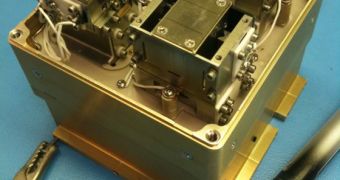A group of experts from the NASA Goddard Space Flight Center (GSFC), in Greenbelt, Maryland and the Naval Research Laboratory (NRL) announce the creation of a tiny, yet very potent satellite payload that can be outfitted on an emerging class of spacecraft called Cubesats.
These are very small cubic satellites, often a meter or less in size, that can provide only limited power supplies, but which can be deployed at an extremely low cost. Regular-sized satellite cost in excess of $100 million, and can reach as high as $400-500 million.
As such, GSFC technologist Dr. Fred Herrero decided to being searching for an alternative to these spacecraft more than 10 years ago. The Winds-Ion-Neutral Composition Suite (WINCS) instrument is the coronation of all his hard work.
During the development process, the expert worked in collaboration with NRL colleague Andrew Nicholas. Their stated goal was to enable studies of Earth's upper atmosphere by using a vast constellation of satellites gathering multi-point measurements simultaneously.
But this would have necessitated billions upon billions of dollars, and both experts knew such a constellation would never materialize with standard satellites. However, such an observations grid can be put together from Cubesats carrying WINCS instruments.
Their goal is to study the ionosphere and thermosphere, which are both layers of Earth's atmosphere. They extend between 60 and 350+ miles above the planet’s surface, and are very difficult to analyze.
The first of several WINCS units is expected to be delivered out of Dr. Herrero's labs this autumn. His team also includes GSFC technologists Rusty Jones and Patrick Roman. Each units contains no less than four spectrometers and three detectors.
This remarkable capability is contained within a 3-inch package that requires as little as 1.3 watts of power to operate properly. Both the Defense Department (DoD) and the National Science Foundation (NSF) have been promoting Cubesats capable of carrying these payloads for years.
“By merit of Moore's law, the goal of any technological development should be the reduction of volume and power. WINCS is a significant and brilliant step in that direction,” Jones explains.
“Because of Fred’s insights, I suspect that one day in the foreseeable future, we will see mass spectrometers the size of wristwatches,” he goes on to say. Moore's law plainly states that the number of transistors that can be placed on an integrated circuit doubles every two years or so.
It was originally developed in response to the rapid development of microprocessor technologies, but it soon proved it can be applied in other domains with a relatively fixed rate of growth as well.
“In the fall, the team will deliver the first of three to NRL, followed by one to the Air Force Research Laboratory, one to the University of Michigan, and two to Boeing Aerospace, which is developing a Cubesat mission for the Air Force,” a NASA press release reports.
“Once we deliver the first, it will be like a little factory here. What's amazing about WINCS is not just its small size. It also will enable measurements we’ve never made before. For the first time, we will be able to measure the full vector of wind,” Herrero adds.
He explains that a Spanish aerospace company and the European Space Agency (ESA) are also interested in purchasing this technology for their own satellites.

 14 DAY TRIAL //
14 DAY TRIAL //